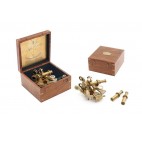

| Los pedidos realizados el día 25 de Julio, se procesarán el día 26 por fiesta local. |


Brass sextant with an acacia wood box elegantly decorated with brass inlays.
The sextant was designed for sea navigation. It allows to obtain the angular height of the sun over the horizon. It was invented in the 1730s by two people: John Hadley (1682-1744), English mathematician, and Thomas Godfrey (1704-1749), an American inventor. He quickly replaced the astrolabe and octant as the main instrument for navigation. The sextant consists of a small telescope, to look at the horizon, two mirrors (which reflect the image of the object), filters (for the sun), a movable arm and a graduated circle arc. The opening angle is 60º, one sixth of a circle, hence the name of the instrument.
Brass sextant with an acacia wood box elegantly decorated with brass inlays.
BRUNTON Pocket Transit compass. Working reproduction of the pocket transit compass invented by mining engineer D.W Brunton in 1894.Brass compass presented in lovely rosewood box with brass anchor motif inlay. The two rotating bubble levels give the declination angle reading. The needle is automatically blocked when the lid is closed.
Reproduction of a compass-sundial in brass of the type that Christopher Columbus would have used.
High precision tide indicator. An indispensable instrument to know the level of the tides throughout the year and to be able to enjoy the sea or the beach at high or low tide hours. Once you receive the instrument, adjust it to the tide times of the place where you are during the full moon. The tide indicator only needs to be adjusted once at the place...
Elegant nautical-inspired compass made of brass. The bottom of the compass is decorated with a printed compass rose. This nautical piece is an original gift idea and this instrument was used to determine directions at open sea.
Reloj marino ubicado en un ojo de buey en latón barnizado. Un objeto clásico y elegante.
Reproduction of a 4-tube telescope in aged brass. Delivered with a beautiful sheesham wood box decorated with brass inlays. The spyglass arose between the 16th and 17th centuries. The creation is attributed to the Dutch Hans Lippershey. In the past it was used mainly by sailors and naturalists.